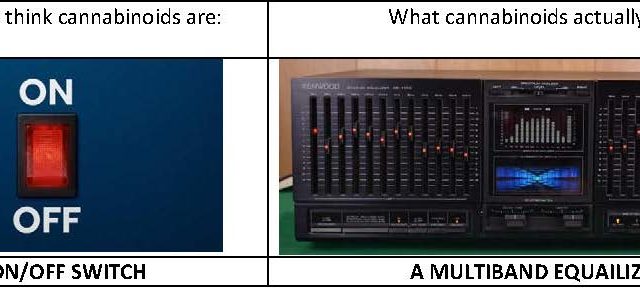
How changing the way we think about cannabis will create new commercial opportunities
The cannabis plants of ancient history were different than most of the examples we know today. As usage of the cannabis plant spread, selective breeding and refinement lead to greater variations and potencies of active chemical components within the plant. An appropriate analogy is to compare the variations we see today to how most modern domestic canines are common genetic ancestors of wild wolves. Just like the dogs we share our homes with today, modern cannabis plants come in a wide array of shapes and sizes that showcase their unique attributes.
However, unlike dogs, cannabis breeders focused on creating increasing one key molecule: delta–9-tetrahydrocannibinol (Δ-9-THC, or simply THC). This molecule gets its notoriety from its psychoactive effects, which have long overshadowed additional therapeutic and palliative applications. As decades of cannabis prohibition prevented legitimate research and development, an underground black market focused on increasing the plant’s THC content to satisfy the demands of its illicit customer base.
In recent years, cannabidiol (CBD) has grown in popularity and lead to the emergence of high-CBD strains and preparations that have demonstrated pharmacological benefits. These benefits are different to those of THC and do not carry the same psychoactive effects. In many treatment cases these molecules complement each other, creating more effective results than if they were used independently. When properly calibrated, cannabinoids appear to have the ability to regulate numerous physical processes, including mood, sleep, digestion and appetite, and pain-sensation.
Cannabinoids & Endocannabinoid System
Cannabinoids are bioactive compounds that interact with a network of receptors in the nervous system known as the endocannabinoid system. They can be further subdivide into phytocannabinoids(plant-derived)and endocannabinoids (native molecules produced naturally in the body).
The human body creates and uses cannabinoids naturally. The endocannabinoid anandamide, for example, plays a part in the “runners high” that can follow prolonged exercise periods. Studies also suggest it may also play a role in the proper development of human embryos[i]. Regardless of an individual’s exposure to plant-derived cannabinoids found in cannabis, every human being alive today already walks around with (endo) cannabinoids in their body.
By acting on the CB1 and CB2 receptors, phytocannabinoids can regulate systems within our body just like endocannabinoids. As medical science continues to study the specific roles of native compounds and the endocannabinoid system, we also learn how phytocannabinoids operate to influence our physiology.
Δ-9-THC and CBD, the Tip of the Iceberg
As we’ve already see with Δ-9-THC and CBD, the list of potential application for these molecules is extensive. Producing the desired effect, however, requires an additional step that can be summed up in a single word: calibration.
When medical cannabis is concerned, specific cannabis medicines are described in terms of their THC/CBD ratio. A high THC medical tincture for treating chronic pain, for example, may have a typical ratio of 20:1. This tells the patient that, by weight, the medicine contains 1mg of CBD for every 20 mg of THC. A cannabis naïve patient may take a beginning dose of just 5mg of such a medicine, but that dose can be effective in addressing the medical needs of that patient.
By contrast, a high CBD medical tincture for the treatment of epilepsy may have a ratio of 1:20. Effective dosages for such treatment can range from 200-300mg or more of CBD daily. According to the Mayo Clinic, treating conditions like schizophrenia or Huntington’s disease can require CBD dosages of over 1,000mg, with only trace amounts of THC.
These examples illustrate how, when using phytocannabinoids as medicine, composition and dosage is everything. In recent years, social and regulatory changes have allow research on the possible uses of phytocannabinoids. As encouraging as these studies are, many focus only on the two cannabinoids in the spotlight. As the list of possible treatments related to THC and CBD grows, interest in the lesser known cannabinoids grows also.
Depending on who you ask, there are between 100 to 500 distinct phytocannabinoids in the cannabis plant. Many differ from other by a single molecular bond but produce vastly different effects. In light of this knowledge, defining the world of phytocannabinoids in terms of THC and CBD is like trying to paint a picture using only black and white. To achieve the greatest potential from the full palette of compounds within the cannabis plant, there must be a shift in how cannabinoids are viewed.
Changing the Perception of Cannabinoids
Wide-held conceptions of cannabinoids suffer unjustly from prejudices associated with their source. For the better part of the last century, there has been limited authoritative information on the biological mechanisms of cannabinoids. In the absence of scientific information to draw conclusions from, the general public tends to view all cannabinoids as basically the same thing. Up until 2018, any derivative of cannabis was classified as a Schedule I drug by the United States Food and Drug Administration. Schedule I drugs, by definition, are considered to have no redeeming social value or medical application.
Under this classification, all cannabinoids were on level footing, as far as federal regulation was concerned, with heroin. In an historic turn of events related to the passage of the 2018 Farm Bill, CBD was reclassified as a Schedule V drug, acknowledging its low potential for abuse and valid medical applications. Counterintuitively, the FDA’s rating system still considers THC to be more dangerous and less medically useful than cocaine or many potentially lethal opioids.
By lumping them all into the same boat, the FDA’s categorizations relegated all cannabinoids to a stigmatized class. By doing so, advancements in medical applications of CBD were hindered for decades. With hindsight, this clearly demonstrates the pitfalls of painting all cannabinoids with the same brush. It is impossible to tell now how many lives could have been changed if drugs like Epidiolex (an FDA-approved CBD medicine) had arrived sooner.
To fully realize their undiscovered, we must expand the scope of what we believe cannabinoids are capable of. We must evaluate each cannabinoid on its own and in combination with other to appreciate their unique qualities and their nuanced biological interactions. We must stop thinking of them as a simple on/off switch that exists in an activated or inactivated state. In actuality, cannabinoids more closely resemble a multiband stereo equalizer.

By dialing in the proper amounts of each frequency, an equalizer can produce different sound qualities and experiences. The settings that produce the best jazz sounds may not work well for dance music. Equalizing the outputs allows a listener to personalize their experience and results. When properly tuned, cannabinoids have the ability to modulate (upregulate and downregulate) dozens of processes within our body. Different “settings”, i.e. the presence and amounts of various cannabinoids, can be determined to maximum desired effects and reduce undesirable side effects.
This concept greatly expands the possible applications of cannabis and reconciles its seemingly contradictory effects. As neurotransmitter modulators, for every effect that the plant’s compounds can produce, it can also produce the opposite effect. Individual strains of have different reputations because their cannabinoid makeup is different. Some cause relaxation and sleepiness while others are known for making patients energetic and creative. Some work well for PTSD, while others work well for appetite stimulation. Any attempt at describing the effects of cannabis as a whole will always fall short of being comprehensive, because of the broad scope of possible effect.
iMaccarrone M, Valensise H, Bari M, Lazzarin N, Romanini C, Finazzi-Agrò A (2000). “Relation between decreased anandamide hydrolase concentrations in human lymphocytes and miscarriage”. Lancet. 355(9212): 1326–9.
MJ Shareholders
MJShareholders.com is the largest dedicated financial network and leading corporate communications firm serving the legal cannabis industry. Our network aims to connect public marijuana companies with these focused cannabis audiences across the US and Canada that are critical for growth: Short and long term cannabis investors Active funding sources Mainstream media Business leaders Cannabis consumers











No comments so far.
Be first to leave comment below.